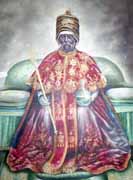
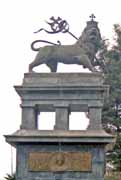
The Lion of Judah
I
have wanted to visit Ethiopia for a long time, but revolution and war caused tourists' choices to be sparse. When I saw that the trip had returned to the 2002 Explore catalog, I
signed up right away. After all, I
didn't want to be crowded out by the Christmas rush. There was no need to worry; hardly
anyone wants to go.
Departure
is from Orlando. First a flight to
Miami, then on to London. It's a
777, so it's fairly comfortable even in steerage. A few hour layover, then the suffering begins. The plane is painted "British Airways," but the flight is operated by
British Mediterranean, which runs smaller planes to lesser destinations. Eleven hours crammed into an A320
(equivalent to a 737). Five hours
to Alexandria, where we stop for fuel and a few people get off, then on to
complete the journey. (It was the
same deal went I flew to Tehran, stopping in Baku.) Cattle class is full, as expected, the white people, your
correspondent excepted, are sitting up front in Bwana Class. The flight attendant is a frog with a
simultaneous supercilious and condescending attitude; he has an insult or snide
remark for each person throughout the flight. He must be in training for Air France.
I
leave Jacksonville Friday afternoon and travel continuously. Arrival in Addis Ababa is at 2:40 AM
time Sunday morning. I get to the
hotel around 3:30 AM. The tour
leader has left me a note that there is an optional all day trip to the Rift
Valley leaving at 8 AM. No, thank
you.
The
hotel is surprisingly upscale and luxurious, That is on an African scale. On an absolute scale, it is barely OK (it would be about
$10/night in South America; here they charge $60). Its crudely printed brochure advises us that the restaurant
serves "palatable food." The hotel
duty free shop is a tiny nook crammed with canned mackerel, Spam, cameras,
cigarettes, suits, shirts, and shoes. On checking in I turn on the TV to the BBC news. The first story is on the looming
catastrophe of famine in Ethiopia. (Actually, things aren't so bad: out of a population of 55 million only
about 10 million are starving.)
Sunday
morning I set out to explore the city. It's not an old city, having been
founded only around a hundred years ago. Wide tree lined avenues and ugly buildings in concrete moderne
style. There are not quite enough
government ministries and conference centers to fill them all, so shanties are
interstitial.
Tourists
don't come to see African cities, and Addis is no exception. A couple of big
churches, a few monuments. Names
like Churchill Ave and DeGaulle Square along with Tito Ave and Lenin
Square. It's fairly clean; not an
enormous amount of trash and garbage. There are plenty of flies, and PLENTY of
beggars. I am the only white guy
out on the street; they couldn't have been all waiting for me to show up and
give them money, but it sure seems that way. The people are strikingly attractive: golden-brown skin,
fine featured, tall, and, of course, skinny. They are ethnically very different from the west africans
from which our negroes descend.
 |  |
| Haile Selassie is | The Lion of Judah |
Addis
lies at 8000 ft, so even though we are just 9 degrees north of the equator the
climate is very pleasant: sunny and warm during the day, cool at night, low
humidity.
There
is very little advertising and billboards, mostly AIDS propaganda. I pass a movie theater showing Black
Hawk Down. I think I know who the audience will be
rooting for. At the Cinema
Ethiopia they are showing Proof of Life -- another bad idea, since it's a step-by-step
guide to kidnapping foreigners for ransom. In the window of the Yemen Airways ticket office is a large
picture of a guy in pilot's uniform talking on the phone. Shouldn't he be flying the plane? There are lots of Italian restaurants. The only thing they appreciate from Mussolini's occupation
in the 1930s is the food.
I
stop by the National Museum and visit Lucy, our great, great, great X 1000
aunt. She is a chimp-sized 3.5
million year old prehuman skeleton found in the Rift valley. An informative exhibit depicts all
sorts of really weird-looking giant mammals that used to live in Africa and
have gone extinct (memo to ecoweenies: stop worrying over every last bug).
I am
back in my hotel room typing this. The TV is tuned to RAI, the channel from Italy: scantily clad girls jump
and jiggle about a studio while the soccer scores crawl across the bottom of
the screen. (The games are all 0-0 or 0-1.) Ah, the essence of sports
programming.
I
meet the rest of the group. We are
twelve: ten from England, a Canadian, me, plus English tour leader. Mostly middle-age guys, but that's
okay, so am I. We depart Monday at
5:30 AM for a flight 200 miles north to Bahir Dar. The flight on an Ethiopian Air turboprop takes 55
minutes. By land, it's a two day
drive.
Ethiopia
became Christian in the fourth century, and the shore and islands of Lake Tana
are dotted with old monasteries. We take a boat ride to one of them. The main church is round, made of mud, with a thatched
roof. The inner walls are decorated
with paintings in the unique Ethiopian Coptic style. Scenes from the Bible and
local legends are depicted in 500 years old wall paintings.
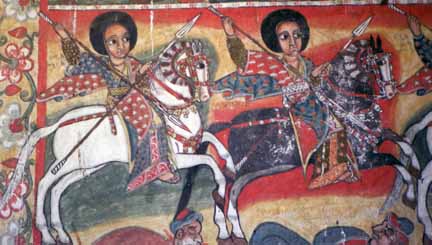
Lake
Tana is the source of the Blue Nile. On the way back we enter its
headwaters. From this point it's
only 2000 miles downstream to the Pyramids.
Tuesday
morning I miss the 6:30 AM boat departure looking for hippos. After breakfast I get the report: they
saw five, but they were in the water and not wearing their tutus.
The
main morning activity is Tissot Falls, second largest in Africa after Victoria
Falls. About 20 miles from its
start the Blue Nile plunges over a cliff. I am sure it was much more impressive
before they built a hydroelectric station and diverted most of the water. The
Falls are reached by a 40 minute hike down into the gorge. I join the 2 hour optional continuation
to the base of the Falls.
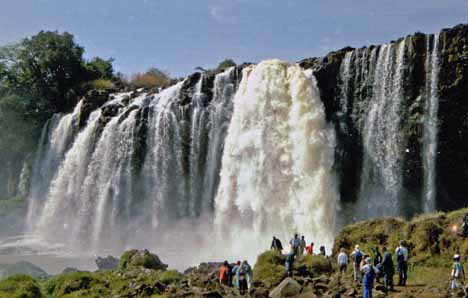
In
the afternoon, some of the group visit more of the island monasteries. The rest of us get the city tour
(nothing), visit the market (not much) and stop by Haile Selassies' Lake Tana
palace (closed) for a view. We
also get a demonstration on how to turn a bundle of reeds into a papyrus
canoe. One sees the canoes all
over being used for transport and to carry cargo. Luckily, we don't have get the opportunity to ride in
one. Although it floats, papyrus
is not watertight; the canoe is waterlogged and you sit half submerged.

The
main industry in Ethiopia consists of accosting tourists and trying to talk
them into parting with money. It's
not just people selling stuff, everybody is in on the action. And everyone has a story: "I need
tuition to continue in school; I need a physics textbook; please buy me a
dictionary; my soccer team needs a ball," etc. Judging from the career plans announced by the mendicants,
in 20 years Ethiopia should be one the world's healthiest, best-educated places
because everyone is going to be a doctor.
Unfortunately,
there are very few tourists to bother, so the per tourista hassle factor is
enormous. People have absolutely
nothing to do but follow you around all day in hopes that you will relent or
just pay them to go away. I am
sure that a fair number of tourists do, which only encourages the locals end
ensures further misery for future travelers.
For
dinner we go to an Ethiopian restaurant. I take the culinary plunge and order the "assorted national
foods." At the last minute I
lose my nerve and change my order to fish. What I get is not great, but much better than what I don't
get. The starting point for
Ethiopian food is injera, sort of an 18 inch crepe made from a fermented
grain. It comes rolled up like
dinner napkins and looks like gray sponge rubber. It tastes like sour sponge rubber. A sheet of it is unrolled and used as a base on top of which
is dumped the rest of what passes for food. One eats without the benefit of cutlery (or napkins) by
tearing off pieces from another sheet of injera and using it to grab the gloppy
stuff. Fasting doesn't seem like
such a strange practice now.
The
next stop is Gondar. We go by air,
a 20 minute flight. There are only
a couple of flights a day and not many pax, so the airport is not very
well-equipped. Security consists
of a body frisk and a guy thoroughly examining your carry on luggage -- not for
weapons but for cool toys so he can play with them.
Gondar
was the capital of the kingdom from about 1600-1850. It's a small city. In the middle is a medieval looking castle/fort compound. It was built by the Portuguese in the style of their forts and thus
looks very unafrican. It
served as the Italian military HQ and was bombed by the British in 1941. It has only recently been partially
restored and reopened.

The
other thing to see is a 400 year old church with great painted walls and
ceilings. Saints and angels, all
negro. There were once 44 such churches but the others were destroyed by Muslim
invaders from Sudan.

Our
hotel is perched on a hill overlooking the city. It's a tiring 30 minute walk (the hard way) or a 10 minute
ride by horse taxi. Two nights in Gondar.
Ah,
the serendipity of travel! We are
leaving Gondar via bus, but on the way out we stop by a local church where they
are celebrating the feast of St. Mary. The church itself is typical construction: a round sanctuary on a raised
platform. As we approach there are
thousands worshipers garbed in white, all in a festive mood. Brightly colored parasols, beturbaned
priests dancing. One guy is leading a chant, to which the people respond by
ululating. At the climax the
copies of the holy tablets draped in cloth are paraded around the
platform. We are the only white
guys there and are given privileged position on the platform. A dizzying
spectacle, and probably the highlight of the trip.
 |  |  |
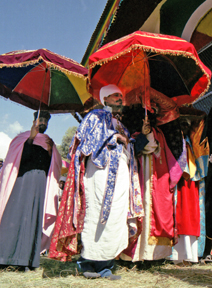 | 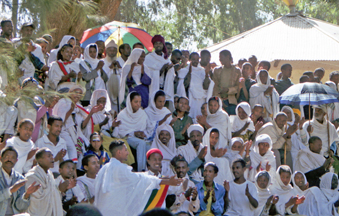 |  |
The
rest of the day is spent driving through the Ethiopian highlands. We are on our way to Debark, gateway to
the Simien Mountains National Park. The area around Gondar is obviously the breadbasket of Ethiopia --
fields of grain stretch across the rolling hills in all direction. Too bad they waste it by turning it
into injera. As we drive through
small towns and villages the children race out and wave furiously as if we were
Santa Claus on his sleigh.
Debark
is not much to see. 28,000 souls;
4 TVs; and 1 Peace Corps worker from Newark. The hotel is even more dire. (We have one of the TVs, which is tuned to English carriage
racing.) Walking through town
generates a reaction like George W. Bush walking down main street. The kids are shouting out "pen,
pen!" They want one. They also shout out "plastic, plastic!" No, they do not want to borrow my
credit card, they want our empty drinking water bottles. Near the market a crowd has gathered:
someone has caught a rat in a live trap. The rat is released, and they stone it to death. (That's what you get when there is no
TV.) Back at the hotel many jokes
about the "roasted meat" listed on the menu.
The
next day is trekking, sort of. We
drive into the mountains where we walk along the escarpment. Very scenic, but looks just like Utah,
except for the baboons. The gelada
baboons, about which David Attenborough has made a documentary, are unique to
the area. The males have big manes
and bright pink patches on their chests. They live in large troops. Unlike most baboons, these don't attack people so we walk right through
them.

The
uphill bits are pretty tiring since we are two miles above sea level. The highlands are generally about
5-6000 ft in elevation, and we are a good ways higher.
The
mountains are OK, but hardly worth bouncing along on hot, dusty, unpaved roads
for hours to get there,
It
gets worse. The next day we spend
all day getting to Axum. Through
what was previously considered impassible country, the Italians built a road. We drive through the mountains on a
precarious track descending a mile on many, many switchbacks on hairpin curves.
Ethiopia
has a unique problem: as the only uncolonized country in Africa, it is
difficult to blame the white man for their problems. That doesn't mean they don't try: as much as possible of
what is wrong is ascribed to the Italian occupation of 1936-41, even though
that is when much of the country's infrastructure was built.
After
the road flattens out we are in Tigre province, the site of the 1985 famine
that is the typical image of Ethiopia. The area is semi-arid, and the rains
failed that year. Because the
province was in rebellion, the Soviet-backed central government deliberately
withheld food and food aid. That
turned out to be their undoing.
Along
the way are wrecked military vehicles. At one spot there are numerous burned-out Russian-built tanks and
armored vehicles alongside the road. Our guide explains that this was the site of a decisive battle in 1989
that broke the back of the central regime. The rebels, the Tigre Peoples' Liberation Front, went on to
defeat the communists and became the present government, albeit with a name
change.

The
hotel in Axum is a carbon copy of the last two. They just keeping reusing the blueprints. In each city a choice piece of real
estate overlooking the main tourist attraction has been commandeered and a
tourist hotel built. They are is
owned and operated by the government and have no private competition. You can imagine the level of
motivation: the words "service" and "welcome" are unknown in their lexicon. The
problem with this hotel is that is was built without a water supply. There is a cistern
which they refill from tanker truck, but the management encourages conservation
by only allowing water to flow to the rooms for one hour a day. An absence of heated water discourages
long showers.
Axum
is the Rome of the Ethiopian Orthodox Church. As any Ethiopian will tell you, St. Mary's church houses the
original ark of the covenant which was spirited away from Jerusalem in 650 BC,
by Menelik, son of King Solomon and the Queen of Sheba (and the ancestor of
Haile Selassie). Only one guy
alive has ever seen it. Since all
Ethiopians know that the ark is there and that it is authentic, they have no
interest in satisfying the curiosity of outsiders. You are allowed to take pictures of the building that houses
it. The story is not as
far-fetched as it sounds. The
Sign and the Seal, by Graham Hancock is a fascinating read.
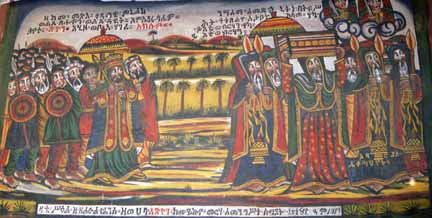
Axum
was also the center of a significant pre-Christian civilization. The whole area is a largely unexcavated
archeological site. In the center of town is a field of stelae which look just
like Egyptian obelisks. The
largest standing one is 75 ft tall; its bigger cousin was carried off to Rome by
Mussolini where it stands in the middle of a piazza. (Where more people get
to admire it than will ever come here.) The biggest of all, 240 ft, has fallen and broken. After Axum converted in the 4th century
they stopped building stalae and started building churches instead.
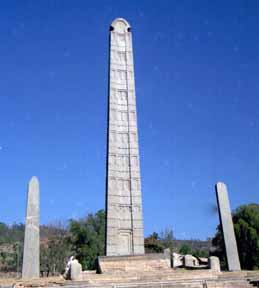
There
are a couple of tombs and ruined palaces, but Egypt this is not. Half the stuff is fancifully named
Queen Sheba's this or that, though most of the sites date to considerably
later.
After
two nights in Axum we fly to Lalibela, to which the capital was moved from Axum
around 1000 AD. It's now a small
town of around 15,000. What
tourists come to set are the rock cut churches, eleven of them, hewn from the
living rock. The roof of the churches are level with the ground and the rock
beneath cut away. The most famous
one is in the shape of a Greek Cross. In the surrounding walls are niches originally used for burials, but now
empty and occupied by hermits.
 |  |
The
hotel is of the same design as the last three, except this one has hot and cold
running water. We arrive and
midday. In the afternoon we visit seven churches.
Lalibela
is REAL poor, even in comparison to the rest of the country. Consequently,
there are LOTS of beggars, venders, and touts. Increasing tourism has meant that people migrate from the
countryside in hopes of getting a job, a coin, or something.
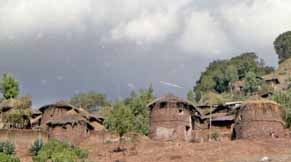 |  |
The
next morning we have a mule trek. We are heading to another rock-hewn church on a mountaintop overlooking
the city. The mules come right to
our hotel. I get a good one (so I
think); while some need two handlers, one pulling and one pushing, mine walks
along on his own while my muleteer goes around prodding more recalcitrant
animals. The path is steep and
rocky, but that is why we are riding. On one particularly steep section and for the last bit we have to
dismount. Just a short bit of
climbing at 13,000 ft leaves one gasping.
The
view from the top is great. The
church is less so, but we have the place all to ourselves. The usual collection of paintings,
manuscripts, and relics.
 |  |
Coming
back down my riding skills are put to a test. At a rest point (flat terrain), my mule gets kicked by one
of the others. That sends him off
bolting at a full gallop. As
I hang on I hear the others in our group shouting "ride 'em
cowboy!" The muleteers run
into his path waving their arms, causing him to take a 90 degree turn and
sending me flying. The
others in the group are very impressed by what they deem my professional
looking rodeo roll, and ask me where I learned how to fall off a horse. Just a couple of scrapes and a sore
shoulder. That's why they call it
adventure travel. I get back on
and complete the ride.
My
wrangler is terrified he has lost his tip. Not to worry. Not only did I tip him, he got a pair of my
old Nikes, pants, and a shirt. I
had cleaned out my closet and brought an extras suitcase full of old clothes,
which has considerably enhanced the sartorial splendor of the Lalibela
muleteers.
In
the afternoon, we complete the church circuit.
At
dinner we are treated to a coffee ceremony, or "How to Spend All Evening Making
a Cup of Coffee in a Country With No Other Entertainment." Prediction: the coffee ceremony will
not survive once satellite TV arrives.
It
is not possible to get to Harar, our next destination, in a single day. We take a morning flight from Lalibela
to Addis, where we overnight. We
arrive at the hotel around 3 PM. (There is a lot of waiting involved.) I visit the National Postal Museum, which is more
interesting than it sounds and where I have a spirited discussion with the
curator. He thinks Communism
failed in Ethiopia because it is a poor country but that it would be just great
for the United States.
Thursday. I am a cripple! Yesterday my shoulder was sore, but
nothing debilitating. Today my
left arm is totally useless. And
it hurts like hell! Even worse, I
can't move anything else without disturbing it and causing great pain. Injury
or not, the tour must go on. We have a ridiculous 5:45 AM hotel departure for
the airport. We fly to Dire Dawa,
the second largest city in Ethiopia. Its principal industries are growing coffee and chat (a/k/a kat, qat), a
mild narcotic chewed as a leaf. Daily flights take fresh
chat to Djibouti and Somalia. Dire
Dawa is also a station on the Djibouti-Addis railroad through which this
landlocked country imports and exports. Not much in Dire except a big smugglers' market. There is plenty of grist for jokes
along the lines of the Dire Hotel, Dire Restaurant, etc. There is a pharmacy where I buy a
bandage to make a sling for my arm. (If I am going to suffer, I might as well get some sympathy.)
We
drive to Harar, about an hour and a half away, where we arrive around
noon. Harar is a walled city that
was the center of an independent emirate until conquered and made part of
Ethiopia around 1889. It is
supposed to be the fourth holiest city in Islam (who's counting?), and was
forbidden to infidels. The explorer
Richard Burton, disguised as a Muslim, was the first white visitor around
1850. Later on, the French poet
Rimbaud lived here. It is close to
Somalia, so it has its own smugglers market, this time stuff from Somalia
rather than Djibouti. Cigarettes, electronics,
luxury goods, all definitely duty free.
 | 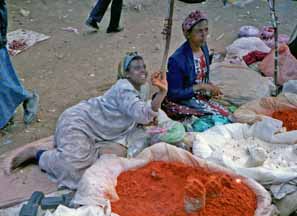 |
In
the afternoon is our city tour. The
walled city is only 1 square km, but contains a maze of small streets and
alleys and 83 mosques. I would
have thought that the purpose of building a wall was to protect a city's wealth
from invasion and plunder, but the city inside the wall looks as desperate as
that without. However, the people
are especially photogenic though they shy at the sight of a camera.
 |  |  |
Tonight
we pay a visit to the Hyena Man of Harar. Hyenas frequent dump sites outside
African cities. Some nutter in
Harar has habituated himself to them by nightly feedings. Although supposedly an ancient
tradition to placate the animals from stealing children, the guidebooks date
the practice to the 1970s when tourists first arrived. Of course, we pay for the privilege of watching (and participating). He feeds them by holding a piece of
meat between his teeth; we use a 10 inch stick. That is still close enough! This guy has held his position for 12 years. I suspect he makes a pretty good
living, although no one else seems to want to set up a competing business.
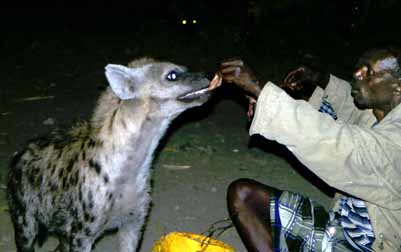 | 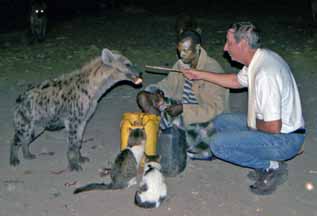 |
We
stay in a private hotel. Even
though it is simple, it is the best yet. When the power goes out in the evening for a few hours, they are able to
serve dinner by candlelight without missing a beat.
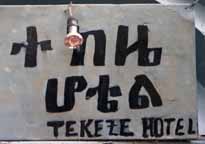
Friday
morning: time for the city tour, part 2. We get a special treat: in Harar, Friday is Leper Day! It is considered the best day for
begging so the inhabitants of a nearby leper village hit the town. In addition to the usual starving,
blind and crippled, we now also have the grotesquely disfigured hurling
themselves at us.
We
visit the house that Ras Tafari lived in before he became went to Addis, became
king, and changed his name to Haile Selaisse. After Harar was conquered by
Ethiopia his father was made governor. The palace is now the town hall. The residence is occupied by a witch doctor. We peek in: the doctor is in, but snoozing away waiting on
his daily chat delivery which his patients silently wait. Too bad, maybe he had something that
would grow me a new arm. (I reject
the possibility of convential medical attention; right by the hospital is a
blacksmith, where I think I saw them beating hot iron into surgical tools).
Our
itinerary includes the insides of houses built in traditional Harari
style. Reminds me of a visit to a "dwelling of a proletarian" in the Soviet Union or a "commune worker's house"
in Red China. It just happens that
the owners' kids are all working overseas and sending back money. The houses are nice, but methinks
hardly typical. We also visit what is billed as Rimbaud's
house (probably built after he died), known locally as "Rambo's House."
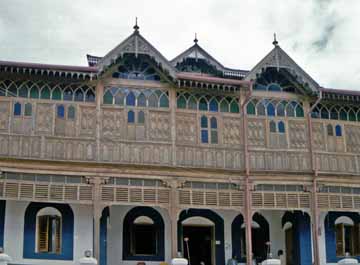
After
two nights in Harar, it's back to Addis. Another hurry up and wait day. We leave the hotel at 9 AM for the 55 minute flight and reach the Addis
hotel at 4 PM. Time for a quick
dash for some final souvenirs and a shoeshine. (I have had LOTS of shoeshines on this trip.)
The
tour company, flush with profits from the exorbitant rates we have been paying (the daily cost of this trip is
roughly the per capita annual income), actually gives us something for
free, They treat us to a dinner
native dance show. Normally, I
shun folk dances performed for tourists, but this was our valedictory dinner
and the price was right.
There
is a well-labeled buffet offering various Ethiopian dishes (and only Ethiopian
dishes). For the first time, I try
the native cuisine. I have not
been missing anything,
To
my surprise, the dancing is GOOD. The best part were the git-down sisters, who really know how to put on
da funk. And the guys could be
straight from Michael Jackson's "Beat It" video, but in African
costume. Too bad the band only
knows one song.
Then,
what started out as an Ethiopian luau morphs into Haile Selasse's Dance
Party. As can be predicted, the
locals got rhythm, but white men can't dance. Luckily, my sling excuses me from the dance floor and any
risk of embarrassment.
Departure
is on Sunday at another ridiculous hour. Despite the 3 hour time difference in my favor, it still takes all
day. I am hoping that my sling
will get me a sympathy upgrade, but no such luck.
The
flight schedules require a stopover in London on the way back, but I have
scheduled two nights. BOY, is this
place expensive! The only bargain
is my very acceptable £25 hotel room (from laterooms.com). The flight is late arriving and it
takes forever to get my luggage, so I don't go anywhere Sunday night. Monday I revisit the British Museum in
preparation for Egypt in February. The theatre pickings are slim; I select a comedy (Stones in My Pocket) at random. It may be in its third year and won all
sorts of awards, but it sucks, and my shoulder hurts. I
bail out at intermission.
It
is not a total cultural washout, though. On the telly I am treated to incessant showings of the utterly
talentless but irresistable The Cheeky Girls performing their Christmas video, Don't Be Shy, Touch My Bum.
December
24th, time to come back. Due to
crowding and delays, it takes forever. I don't get home until 3 AM Christmas Day. Santa has brought me nothing, and my cat is complaining. And my shoulder hurts. Still, an excellent trip.